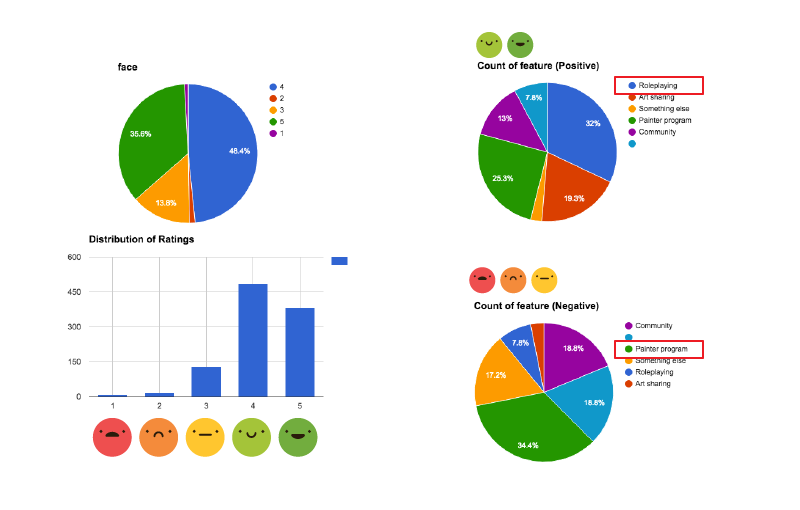PAINTBERRI ARTIST COMMUNITY
Growing a visual forum into a storytelling platform
PaintBerri is an art role-playing and storytelling community co-founded by Katherine Tung and I in 2016. The site began as a side project inspired by the vibrant art communities on Japanese Oekaki boards—visual forums where posts and comments are drawn with a simple painting program.
As a small team, we grew the user base to over 23,000 artists with free and paid accounts, without outside funding or paid advertising.
Through extensive user research and rapid iterative testing, we honed the experience to better meet user needs.
Expertise
Lean product design
User research
Google analytics
UX/UI design, branding
Wearing many hats (aka entrepreneurship)
Project Details
Role: Co-founder
Timeframe: 2.5 years
Key Collaborators
Katherine Tung
Robbin Arcega
When PaintBerri went into open beta, people came flooding in from Tumblr and one of the last English-language Oekaki sites, Tegaki-E, and we assumed it was because PaintBerri had a more robust painting program.
At the same time, we were drowning in complaints from people who had compatibility issues with the painting program or wanted more features.
Excited by the rush of users, the team decided to respond to popular opinion and churned out a series of painter upgrades and features.
Unsure of what was going on, we designed a satisfaction survey and presented it to every logged in user for a few days.
After collecting over 1,300 responses, we dug through the numbers discovered a few interesting things: people who liked the site enjoyed it because of the art role-playing culture, while those who didn't like the site had trouble with the painting program.
At this point, we knew that PaintBerri’s value proposition was too diluted, but weren’t sure what direction to focus it in. In a hasty attempt to try and focus the feature set back towards a traditional Oekaki site, we proposed removing the uploading feature, which was met with immediate distress from the community. A subsequent survey about the uploads feature made it resoundingly clear what our community wanted.
Through months of research and experimentation, the PaintBerri Team finally uncovered what the community wanted: a place to create and share visual stories with friends.
We put up an announcement post detailing the change in direction, and it was enthusiastically received.
Reflection
Validate assumptions early and often
The team spent a lot of time listening to loud users instead of the most engaged ones, which led us on a wild feature-building goose chase. Through this experience, we gained a much better understanding of why engaged users were engaged, and made stronger decisions in the future as a result.
Challenge
Finding out the true drivers for artists coming to PaintBerri
PaintBerri was based off of Oekaki sites, which were popular in America in the late 2000’s. They were a gathering spot for artists to draw online with a simple painting tool, improve their skills, and share art. We thought artists were coming to PaintBerri to draw with the unique browser painting program, but something didn't seem right.
Artists also frequently create visual stories on Oekaki sites, called art role-plays (roleplay, RPs). A role-play is an improvised collaborative comic created by one or more artists telling a story through characters they usually design themselves. At this point, PaintBerri supposed art role-plays, with many posts created such as the following example.
However, despite sinking hundreds of hours into constant upgrades to the painting program and surpassing the feature sets of other Oekaki sites, PaintBerri’s growth was stagnating.
Approach
Surveys, interviews, analytics, and a fiery controversy help the team understand what artists really want
If half of the happiest users were happy because they could art role-play and share their work with friends, then theoretically, the painting program was getting in the way. There was no way PaintBerri could ever feature-match popular desktop painting programs like Photoshop and Paint Tool SAI, so we decided to experiment with allowing people to upload their drawings, which turned out to be very controversial.
In the meantime, we sent out a series of surveys based on Lean Customer Development principles and identified 20 extremely loyal artists who I had a 15-20 minute phone conversation with. From them, we learned that interaction with other artists, tangible recognition from peers, and a platform for art role-playing were central themes to our top users.
Outcome
We also uncovered hard evidence from Google Analytics that told us that artists who participated in groups were more engaged on the site. Almost all the groups on PaintBerri are created to organize art role-plays, stories, and characters.












